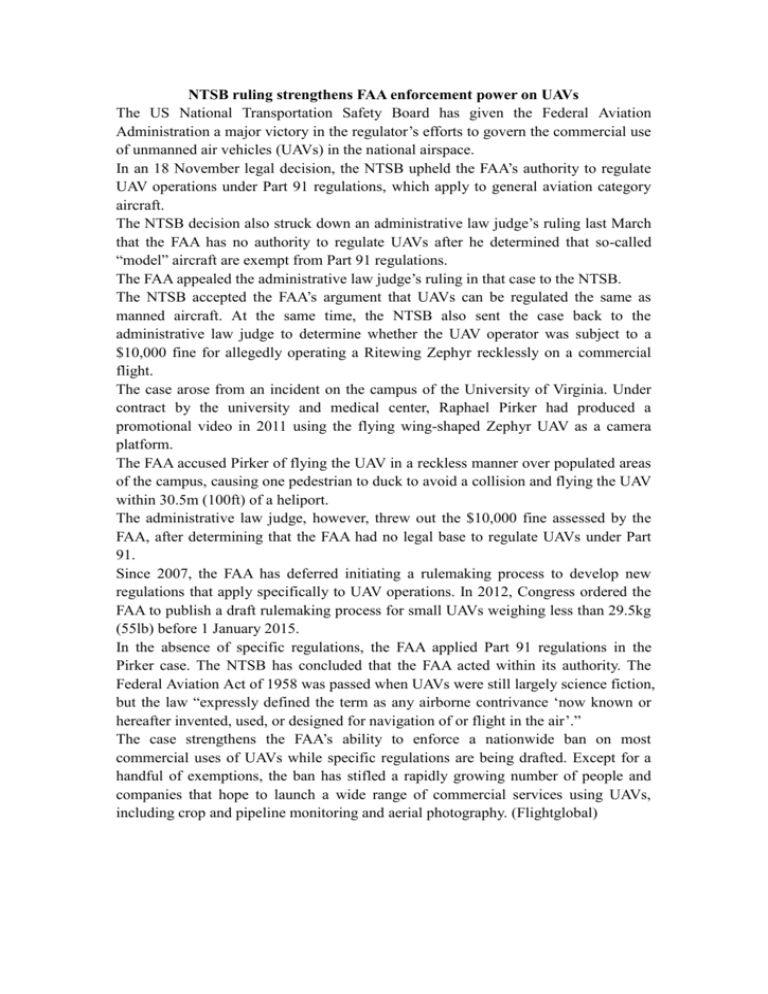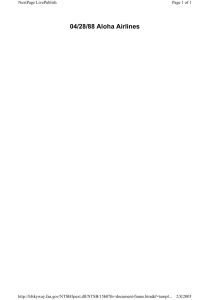NTSB ruling strengthens FAA enforcement power on UAVs
advertisement

NTSB ruling strengthens FAA enforcement power on UAVs The US National Transportation Safety Board has given the Federal Aviation Administration a major victory in the regulator’s efforts to govern the commercial use of unmanned air vehicles (UAVs) in the national airspace. In an 18 November legal decision, the NTSB upheld the FAA’s authority to regulate UAV operations under Part 91 regulations, which apply to general aviation category aircraft. The NTSB decision also struck down an administrative law judge’s ruling last March that the FAA has no authority to regulate UAVs after he determined that so-called “model” aircraft are exempt from Part 91 regulations. The FAA appealed the administrative law judge’s ruling in that case to the NTSB. The NTSB accepted the FAA’s argument that UAVs can be regulated the same as manned aircraft. At the same time, the NTSB also sent the case back to the administrative law judge to determine whether the UAV operator was subject to a $10,000 fine for allegedly operating a Ritewing Zephyr recklessly on a commercial flight. The case arose from an incident on the campus of the University of Virginia. Under contract by the university and medical center, Raphael Pirker had produced a promotional video in 2011 using the flying wing-shaped Zephyr UAV as a camera platform. The FAA accused Pirker of flying the UAV in a reckless manner over populated areas of the campus, causing one pedestrian to duck to avoid a collision and flying the UAV within 30.5m (100ft) of a heliport. The administrative law judge, however, threw out the $10,000 fine assessed by the FAA, after determining that the FAA had no legal base to regulate UAVs under Part 91. Since 2007, the FAA has deferred initiating a rulemaking process to develop new regulations that apply specifically to UAV operations. In 2012, Congress ordered the FAA to publish a draft rulemaking process for small UAVs weighing less than 29.5kg (55lb) before 1 January 2015. In the absence of specific regulations, the FAA applied Part 91 regulations in the Pirker case. The NTSB has concluded that the FAA acted within its authority. The Federal Aviation Act of 1958 was passed when UAVs were still largely science fiction, but the law “expressly defined the term as any airborne contrivance ‘now known or hereafter invented, used, or designed for navigation of or flight in the air’.” The case strengthens the FAA’s ability to enforce a nationwide ban on most commercial uses of UAVs while specific regulations are being drafted. Except for a handful of exemptions, the ban has stifled a rapidly growing number of people and companies that hope to launch a wide range of commercial services using UAVs, including crop and pipeline monitoring and aerial photography. (Flightglobal)









